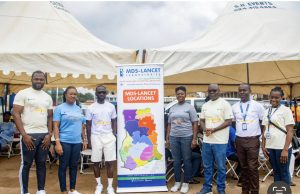By Edzorna Francis Mensah
Saviour Gad, a Ghanaian professional boxer who holds the National Champion title, will battle it out with Kenyan boxer Konney for Super Middleweight on 1st November 2024 at Aborigines Beach Resort, a few hours from the Hogbetsotso Za, slated for 2nd November 2024.
Saviour Gad from Ketu South in the Volta Region has so far appeared ten (10) times for international fights and won nine (9) and sources close to his camp, has it that, Saviour is well prepared to fight his eleventh match this weekend in honour of Awomefia of Anlo State, Togbui Sri III under Aborigines Boxing Promotions. Mr. Gad will early January 2025 face UK Boxer Frezzy Macbone to begin the year.
The Hogbetsotso festival is celebrated by the chiefs and people of Anlo in the Volta Region of Ghana. Some major Anlo towns include Anloga (capital), Keta, Kedzi, Vodza, Whuti, Srogboe, Tegbi, Dzita, Abor, Anlo Afiadenyigba, Anyako, Konu, Alakple, Atsito, Atiavi, Deʋegodo, Atorkor, Tsiame and many other villages.
The festival is celebrated annually on the first Saturday in the month of November at Anloga, the customary and ritual capital of the Anlo state.
The name of the festival is derived from the Ewe language and translates as the festival of exodus. or “coming from Hogbe (Notsie)”. The celebration of the festival was instituted about four decades ago.
The Anlo are a group of people from a tribe on the eastern coast of Ghana. Prior to their settling in their present location, they lived in Notsie, a town in present-day Togo. It is believed that they had migrated from southern Sudan through Oyo, an area in Nigeria, Ketou in Benin and Adja Tado in Togo to settle in Notsie.
Oral tradition has it that they lived under a wicked king, Togbe Agorkoli (Agor Akorli). In order to escape his tyrannical rule they had to create a hole in the earthen wall that surrounded their town.
They achieved this by instructing the women to pour all their wastewater at one particular place in the wall.
Over time the spot became soft, thereby allowing the town people to break through the wall and escape through the resulting mud. Tradition also holds that, to confuse their pursuers, buying time to make good their escape, they walked backwards with their faces towards the town so that their footprints appeared to go into the town.
The festival is traditionally observed on the first Saturday in November, featuring various ceremonies.
These ceremonies encompass a peace-making period during which all disputes are resolved through amicable solutions. It is believed that the reason for this traditional period of peacemaking is that the people believe their ancestors lived in harmony with themselves all through their escape from Notsie and that it was this character that made their sojourn a success.
There is also a purification ceremony of the ceremonial stools (where the Ewe believe the ancestral spirits reside) through the pouring of libations. This is followed by general cleaning where all the villages are swept and rubbish burnt.
This cleaning ceremony starts at the Volta River and ends after several days at the Mono River in the Republic of Togo. The climax of the festival involves a durbar of the chiefs and people of Anlo. The chiefs dress in colourful regalia Kete/ kente, and receive homage from their subjects at the durbar grounds. Various forms of dancing, singing and merry-making characterize the entire festival.
















